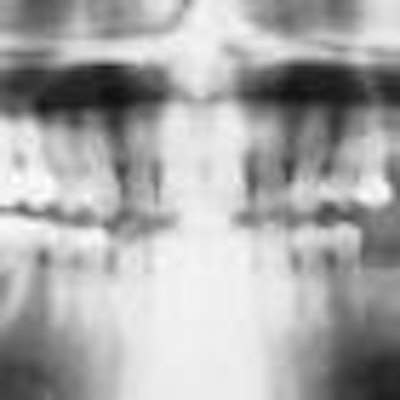
Advances in the study of the effect of dental x-rays on oral mucosa cells have shown that radiation exposure can induce DNA damage and cytotoxicity in these cells, according to a literature review in Dentomaxillofacial Radiology.
Daniel Ribeiro, DDS, PhD, of the Federal University of Sao Paulo in Brazil, conducted a literature search in PubMed, MEDLINE, Embase, and Google Scholar in all publications up to August 2011 using the search term "cytogenetic biomonitoring of oral mucosa cells and dental X-ray." His search yielded more than 30 relevant studies, including several that focused specifically on oral mucosa cells in individuals exposed to dental x-rays
(DR, March 2012, Vol. 41:3, pp. 181-184).
For example, a 2008 study in Radiation Medicine (now the Japanese Journal of Radiology) found that x-ray exposure increases the incidence of nuclear alterations -- such as karyorrhexis, pyknosis, and karyolysis -- that are closely related to cellular death (July 2008, Vol. 26:6, pp. 325-330). Another study found that x-ray radiation emitted during panoramic dental radiography (effective dose: 21.4 Sieverts) induced a genotoxic effect on epithelial gingival cells that increased the frequency of chromosomal damage and nuclear alterations (DR, October 2008, Vol. 37:7, pp. 398-403).
And still another found that panoramic radiography increased the number of nuclear anomalies, with significant statistical differences (p < 0.05) in exfoliated cells from the lateral border of the tongue (Mutation Research, August 15, 2007, Vol. 632:2, pp. 121-125). Similarly, in a 2010 assessment of mutagenicity and cytotoxicity in patients undergoing orthodontic radiographs, Dr. Ribeiro and colleagues found that x-ray exposure increases certain nuclear alterations closely related to cytotoxicity, including karyorrhexis, pyknosis, and karyolysis (DR, October 2010, Vol. 39:7, pp. 437-440).
"It is important to stress that cytotoxicity interferes with micronucleus induction, since some micronucleated cells are inevitably lost after cytotoxic insult, confirming the lack of mutagenic effect induced by x-ray," Dr. Ribeiro wrote. "This is because repeated exposure to cytotoxicants can result in chronic cell injury, compensatory cell proliferation, hyperplasia, and, ultimately, tumor development."
Children and smokers
When the effect of dental x-ray exposure in children was investigated, no statistically significant differences (p > 0.05) were found between micronucleated oral mucosa cells before and after radiation exposure (Pediatric Radiology, June 2007, Vol. 37:6, pp. 561-565). However, here again the researchers found that radiation did lead to other nuclear alterations closely related to cytotoxicity, including karyorrhexis, pyknosis, and karyolysis.
"As a result of industrialization and urbanization, children's health has been endangered frequently by exposure to genotoxic chemicals," Dr. Ribeiro wrote. "This is because children, as developing individuals, may express increased susceptibility to environmental hazards owing to differences in uptake, metabolism, distribution and excretion of DNA damagers."
Other studies have focused on the effects of x-ray exposure in the oral cavity among smokers. DNA mutations are detected in tumors closely associated with smoking, such as those located in the oral and oropharyngeal cavities, Dr. Ribeiro noted. In particular, studies of epithelial tissue from smokers have shown elevated levels of DNA damage and increased DNA mutations compared with epithelial tissue from non-smokers.
For example, while a 2010 study in Clinical Oral Investigations (December 2010, Vol. 14:6, pp. 669-674) found no statistically significant differences between micronucleated oral mucosa cells before and after x-ray exposure for buccal mucosa and lateral border of the tongue in both smokers and nonsmokers, the researchers again found that x-ray exposure increased other nuclear alternations closely related to cytotoxicity -- including karyorrhexis, pyknosis, and karyolysis -- in both groups.
"These data demonstrate that panoramic x-ray can induce cellular death in oral mucosa cells," Dr. Ribeiro wrote. The lateral border of the tongue is a more sensitive site to cytotoxic insult induced by ionizing radiation combined with continuous cigarette smoke exposure, he added.
Cone-beam CT studies needed
Given that there are currently no biomonitoring studies involving cone-beam CT, according to Dr. Ribeiro, his research group evaluated DNA damage and cellular death in exfoliated buccal mucosa cells from adults after undergoing a cone-beam CT scan (effective dose: 12 micro-Sieverts).
Again, while they found no statistically significant difference in micronucleus frequency before and after cone-beam CT exposure (p > 0.05), they did see an increase in the incidence of other nuclear alterations closely related to cytotoxicity, including karyorrhexis, pyknosis, and karyolysis.
"These results will contribute to a better understanding of x-ray-induced effect upon the cellular system in individuals continually exposed to known genotoxic/cytotoxic agents," Dr. Ribeiro concluded.


















